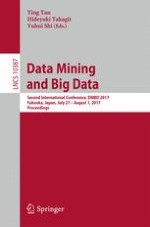2017 | Buch
Data Mining and Big Data
Second International Conference, DMBD 2017, Fukuoka, Japan, July 27 – August 1, 2017, Proceedings
herausgegeben von: Ying Tan, Hideyuki Takagi, Yuhui Shi
Verlag: Springer International Publishing
Buchreihe : Lecture Notes in Computer Science
